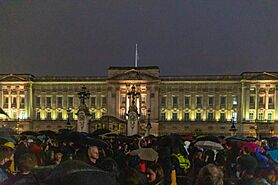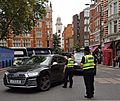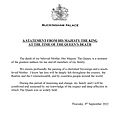Death and state funeral of Elizabeth II facts for kids
Elizabeth II, who was the Queen of the United Kingdom and many other countries in the Commonwealth, passed away on 8 September 2022. She was 96 years old and died at Balmoral Castle in Scotland. Her reign lasted for 70 years and 214 days, making it the longest of any British monarch. After her death, her oldest son, Charles III, immediately became King.
Her death put into action a special plan called Operation London Bridge, which had been prepared since the 1960s for when the Queen passed away in London. There was also a plan called Operation Unicorn for if she died in Scotland, which she did.
|
Top to bottom, left to right:
|
|
| Date |
|
|---|---|
| Location |
|
| Budget | GB£162 million |
| Participants | List of guests at the state funeral |
Contents
The Queen's Passing
A Long Reign Ends
Queen Elizabeth II was a very important figure for many years. Her reign was the longest of any British monarch. This means she was Queen for more time than anyone else in British history. She was admired by many people around the world.
Funeral Plans: Operation London Bridge
After the Queen died, her coffin was first placed at rest in St Giles' Cathedral in Edinburgh. This was from 12 to 13 September. During this time, about 33,000 people came to see it and pay their respects.
Lying in State: Saying Goodbye
Then, the coffin was flown to London. From 14 to 19 September, it was placed in Westminster Hall for what is called "lying-in-state". This is a tradition where the public can view the coffin and say their final goodbyes. Around 250,000 people waited in a long line, sometimes for many hours, to do this. The United Kingdom also had a 10-day period of national mourning. This meant many people felt sad and showed respect for the Queen.
The State Funeral
A Grand Procession
The Queen's state funeral took place on 19 September. This was a very rare event, the first state funeral in Britain since Winston Churchill's in 1965. A special church service was held at Westminster Abbey.
After the service, there was a large procession. About 3,000 military members marched with the Queen's coffin to Wellington Arch. Around one million people gathered in central London to watch this procession.
Final Resting Place
From Wellington Arch, the Queen's coffin was taken by a special hearse to Windsor. Another procession took place through Windsor Great Park. A final service was held at St George's Chapel at Windsor Castle. Later that evening, the Queen was buried privately with her husband, Prince Philip, in the King George VI Memorial Chapel. Only her closest family members were there.
A Global Event
The state funeral was made a public holiday in the UK and some other Commonwealth countries. Many important people from around the world attended. It was also the largest security operation ever in the UK, meaning many police and security staff were involved.
The television coverage of the funeral was one of the most watched special events in the UK. More people watched it than the wedding of Prince William and Catherine Middleton, which was the most-watched royal event of the 21st century before this. The period of mourning and the funeral cost the government about £162 million.
Images for kids
-
The Queen at the opening of the Welsh Parliament, October 2021
-
Elizabeth II lying-in-state at Westminster Hall
-
The press covering the Accession Council outside St James's Palace
-
King Charles III addressing the Scottish Parliament following his accession
-
The Union Flag flown at half-mast at Buckingham Palace
-
The flag of Sudan at half-mast following the death of the Queen
-
The Brandenburg Gate illuminated with the Union Flag on 16 September as a tribute to the Queen
-
A book of condolence for the Queen in the Manitoba Legislative Building
-
Gun salute in honour of the Queen on the grounds of the Manitoba Legislative Building
-
The Queen's Personal New Zealand Flag paraded at the New Zealand State Memorial Service]]
-
A 96-gun salute at Government House, Saint Lucia
-
Some of the floral tributes left by the public in Green Park, London
See also
 In Spanish: Muerte y funeral de Estado de Isabel II del Reino Unido para niños
In Spanish: Muerte y funeral de Estado de Isabel II del Reino Unido para niños
- List of largest funerals

































